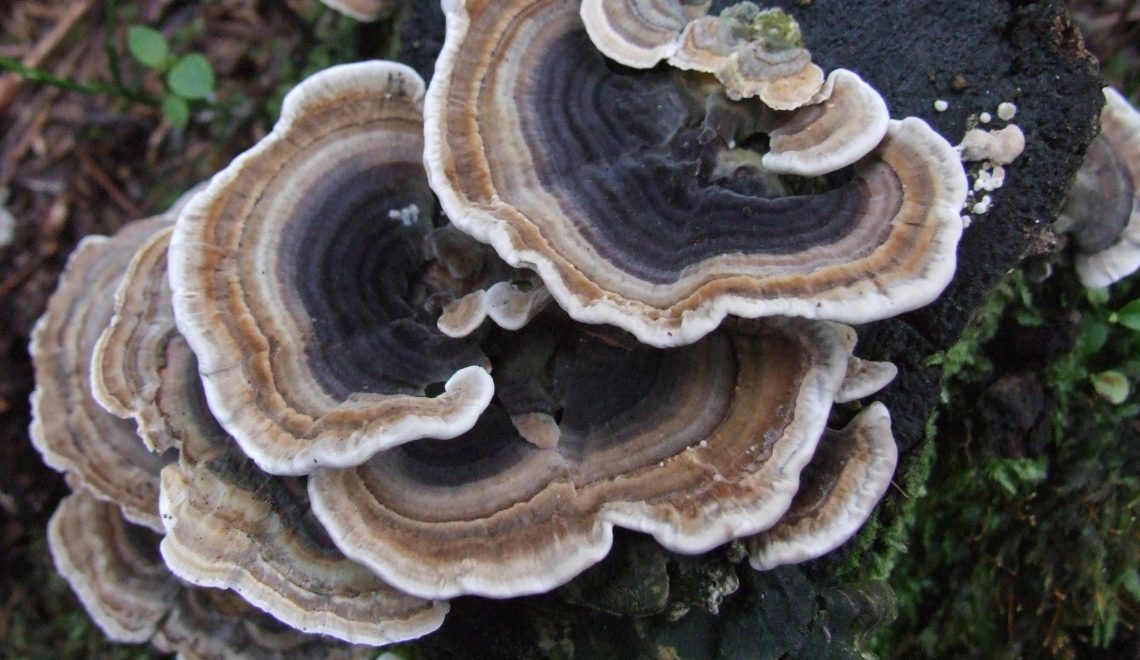
Medicinal Mushrooms have been used for thousands of years
Mushrooms have long been used in healing throughout the world. It is in China, however, in the Shen Nong Ben Cao, that their therapeutic properties were most fully investigated and applied. Such is the high esteem of mushrooms that they are frequently to be found in the art of all the Chinese dynasties.
From the recognisable Oyster and Enoki mushrooms to Reishi and the amazing Lion’s Mane, the book covers all the major medicinal mushrooms with recommendations for the prevention and treatment of many conditions and diseases, from anxiety to diabetes. For example:
- Cordyceps sinensis (Japanese: Tochukas; Chinese: Dong Chong Xia Cao; English: Caterpillar fungus) – anti-aging, improved athletic performance, fertility, diabetes, protection of kidneys, respiratory disease, anti-viral
- Trametes versicolor (Japanese: Kawaratake; Chinese: Yun Zhi; English: Turkey Tail) – stomach, colorectal, lung, oesophageal, breast and cervical cancer treatment, HIV treatment and ME
- Hericium erinaceus (Japanese: Yamabushitake; Chinese: Hou Tou Gu; English: Lion’s Mane) – dementia, MS, nerve damage, MRSA, gastritis.
One of the most amazing qualities of mushrooms is their active polysaccharides (the chains of molecules that make up the mushroom cell walls) and the effect they have on our immune systems. In fact, the polysaccharides of over 650 mushroom species are known to have anti-tumour activity.
What is this Mycelium you speak of?
The individual cells of the mushroom are joined in long chains that form a very tight network, called mycelium, which can spread over many hundreds of acres – there’s a Honey Fungus in Oregon covering 2,200 acres! Fungi mycelial network is the organism and mushrooms are the fruiting body of the mycelium, like apples to an apple tree, popping out to distribute their spores. This is the what is described as the wood-wide-web, the connections that these fungi create relationship with enter forests and transfer nutrients to and from the root systems of trees, but we’ll elaborate on this in a future post.
Medicinal mushrooms are recommended individually or in combination to maximise the effect of their pharmacologically active compounds. Several varieties can be taken safely for long periods of time without any side effects and therefore are invaluable as a component of a preventative medicinal diet. Remember that penicillin the antibiotic was derived from the penicillium mould or fungi that Alexander Fleming discovered in his lab in a petri dish full of staphylococcus bacteria that were getting smoked by the blue green mould.
Whats a good book to start off your medicinal mushroom journey?
So if thats got you interested to learn more about mushrooms and you’re wondering where to find a good resource look no further than expert mycologist and herbalist Martin Powell’s book, Medicinal Mushrooms: A Clinical Guide. This is a great reference book for practitioners, students and anyone interested in the amazing healing power of mushrooms, its got beautiful photos of some tremendous fungi and very easy to use and understand. Also, for all you geeks out there Martin includes excellent references to his extensive research and resources, which allows him to keep every entry short and sweet so its very digestible.
We have some copies of Martin’s book available in our shop and you can also find them and much more on his website www.mycotherapy.co.uk.
Now do me a favour and don’t go self prescribing yourself with every mushroom you see growing on the the tow path and remember to always consult your doctor if you have, or think you may have, a medical condition.
Check out our earlier posts on mushrooms and see some of the great photos taken by patients and friends.
Finally, here is a sneak peak to our top picks for books about acupuncture, Chinese medicine, nutrition health and more.
Turkey Tail image courtesy of Jerzy Opioła – Own work, CC BY-SA 3.0
A beautiful documentary from the BBC – The Magic of Mushrooms
J. Holliday, ‘Medicinal value of the caterpillar fungi species of the genus Cordyceps (Fr.) Link (Ascomycetes) A Review’, International Journal of Medicinal Mushrooms, 2008;10(3)
S. Shin, ‘Cordycepin Suppresses Expression of Diabetes Regulating Genes by Inhibition of Lipopolysaccharide-induced Inflammation in Macrophages’, Immune Netw. 2009 Jun:9(3)
K. Parris, ‘The use of mushroom gluons and proteoglycans in cancer treatment’, Alternative Medicine Review, 2000:5(1)
C. Hobbs, ‘Medicinal value of turkey tail fungus Trametes versicolor (L.:Fr.) Pilat (Aphyllophoromycetideae). A Literature Review’, International Journal of Medicinal Mushrooms, 2004;6(3)
H. Kawagishi, ‘The anti-Dementia effect of Lion’s Man mushroom and its clinical application’, Townsend Letter for Doctor’s and Patients, 2004
A.P. Grygansky, ‘Hericium erinaceus Pers. extract effect on nerve cells’, International Journal of Medicinal Mushrooms, 2001; 3 (2-3): 152

